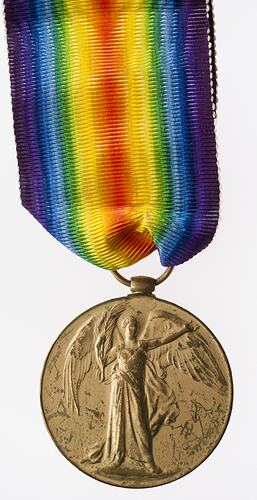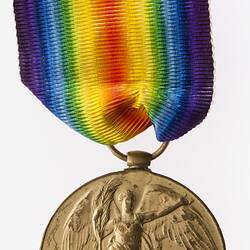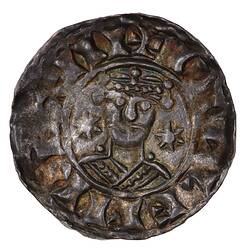Summary
Victory Medal 1914-1919 with ring mount and ribbon awarded to Pte. James Edward Reilly, service number 3923, 51st Battalion, A.I.F.
Private Reilly joined in Echuca, Victoria, on 9 July 1915, aged 24 years and 10 and months. He was a labourer born in Lancefield. Reilly arrived in Marseilles on June 1916 and on 3 September 1916 was missing in action in France. It was later confirmed he was killed in action and buried in an isolated grave, three quarters of a mile east of Thiepval. He was subsequently exhumed and reinterred in a war grave. Private Reilly's medals were sent to his father, William Reilly (incorrectly spelt Riley), Lancefield.
The Victory Medal was authorised in 1919 and was awarded to army, navy and air force personnel who served in a theatre of war between midnight 4th-5th August 1914 and midnight 11th-12th November 1918. The Allies resolved that, if they wished to issue a Victory Medal, it would share a common feature of a depiction of Victory on the obverse and a ribbon of red, yellow, green, blue and violet merged into a rainbow pattern. This medal, that of Great Britain, was awarded to personnel from countries in the British Empire (some 5,725,000 were issued). The other Allied countries that issued Victory medals were: Belgium, Brazil, Cuba, Czechoslovakia, France, Greece, Italy, Japan, Portugal, Romania, Thailand, Union of South Africa and the United States of America.
Obverse Description
Figure of Victory facing three-quarters right with wings spread; in her right hand she holds a palm branch, her left hand is extended and open. The artist's initials, W.McM. (W. McMillan) are above the ground line on the right.
Reverse Description
The words, 'THE GREAT . WAR FOR . CIVILISATION 1914-1919' within a circular wreath of laurel.
Edge Description
Text '3923 PTE. J.E. REILLY 51 BN. A.I.F.'.
More Information
-
Collecting Areas
-
Date Issued
1919 AD
-
Issued By
-
Mint
-
Artist
-
Awarded To
Private James E. Reilly, Australia, 1919
3923 Pte J.E. Reilly, 51st Battalion, A.I.F. -
Inscriptions
Obverse; 'W.McM.' (W. McMillan- artist). Reverse; 'THE GREAT . WAR FOR . CIVILISATION 1914 - 1919'. Edge; '3923 PTE. J.E. REILLY 51 BN. A.I.F.'.
-
Material
Bronze
-
Axis
12
-
Classification
-
Category
-
Discipline
-
Type of item
-
Overall Dimensions
50 mm (Height), 36 mm (Outside Diameter)
Height to top of ring.
-
Shape
Round with loop and ribbon
-
References
References: Australian War Memorial website: [Link 1] [Link 2]
[Book] Joslin, E C., et al. 1988. British Battles and Medals., 230 - 1 Pages
-
Keywords






